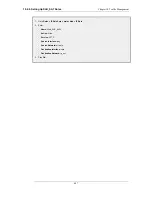
Failover Time
The time for failover is typically about one second which means that clients may experience a
failover as a slight burst of packet loss. In the case of TCP, the failover time is well within the range
of normal retransmit timeouts so TCP will retransmit the lost packets within a very short space of
time, and continue communication. UDP does not allow retransmission since it is inherently an
unreliable protocol.
Shared IP Addresses and ARP
Both master and slave know about the shared IP address. ARP queries for the shared IP address, or
any other IP address published via the ARP configuration section or through Proxy ARP, are
answered by the active system.
The hardware address of the shared IP address and other published addresses are not related to the
actual hardware addresses of the interfaces. Instead the MAC address is constructed by
NetDefendOS from the Cluster ID in the form 10-00-00-C1-4A-nn where nn is derived by
combining the Cluster ID configured in the Advanced Settings section with the hardware
bus/slot/port of the interface. The Cluster ID must be unique for each cluster in a network.
As the shared IP address always has the same hardware address, there will be no latency time in
updating ARP caches of units attached to the same LAN as the cluster when failover occurs.
When a cluster member discovers that its peer is not operational, it broadcasts gratuitous ARP
queries on all interfaces using the shared hardware address as the sender address. This allows
switches to re-learn within milliseconds where to send packets destined for the shared address. The
only delay in failover therefore, is detecting that the active unit is down.
ARP queries are also broadcast periodically to ensure that switches do not forget where to send
packets destined for the shared hardware address.
HA with Anti-Virus and IDP
If a NetDefendOS cluster has the Anti-Virus or IDP subsystems enabled then updates to the
Anti-Virus signature database or IDP pattern database will routinely occur. These updates involve
downloads from the external D-Link databases and they require NetDefendOS reconfiguration to
occur for the new database contents to become active.
A database update causes the following sequence of events to occur in an HA cluster:
1.
The active (master) unit downloads the new database files from the D-Link servers. The
download is done via the shared IP address of the cluster.
2.
The active (master) node sends the new database files to the inactive peer.
3.
The inactive (slave) unit reconfigures to activate the new database files.
4.
The active (master) unit now reconfigures to activate the new database files causing a failover
to the slave unit. The slave is now the active unit.
5.
After reconfiguration of the master is complete, failover occurs again so that the master once
again becomes the active unit.
Dealing with Sync Failure
An unusual situation that can occur in an HA cluster is if the sync connection between the master
and slave experiences a failure with the result that heartbeats and state updates are no longer
received by the inactive unit.
11.2. HA Mechanisms
Chapter 11. High Availability
492
Summary of Contents for DFL-1600 - Security Appliance
Page 27: ...1 3 NetDefendOS State Engine Packet Flow Chapter 1 NetDefendOS Overview 27 ...
Page 79: ...2 7 3 Restore to Factory Defaults Chapter 2 Management and Maintenance 79 ...
Page 146: ...3 9 DNS Chapter 3 Fundamentals 146 ...
Page 227: ...4 7 5 Advanced Settings for Transparent Mode Chapter 4 Routing 227 ...
Page 241: ...5 4 IP Pools Chapter 5 DHCP Services 241 ...
Page 339: ...6 7 Blacklisting Hosts and Networks Chapter 6 Security Mechanisms 339 ...
Page 360: ...7 4 7 SAT and FwdFast Rules Chapter 7 Address Translation 360 ...
Page 382: ...8 3 Customizing HTML Pages Chapter 8 User Authentication 382 ...
Page 386: ... The TLS ALG 9 1 5 The TLS Alternative for VPN Chapter 9 VPN 386 ...
Page 439: ...Figure 9 3 PPTP Client Usage 9 5 4 PPTP L2TP Clients Chapter 9 VPN 439 ...
Page 450: ...9 7 6 Specific Symptoms Chapter 9 VPN 450 ...
Page 488: ...10 4 6 Setting Up SLB_SAT Rules Chapter 10 Traffic Management 488 ...
Page 503: ...11 6 HA Advanced Settings Chapter 11 High Availability 503 ...
Page 510: ...12 3 5 Limitations Chapter 12 ZoneDefense 510 ...
Page 533: ...13 9 Miscellaneous Settings Chapter 13 Advanced Settings 533 ...






























